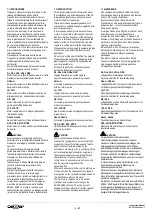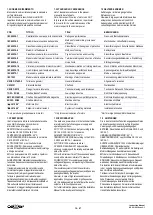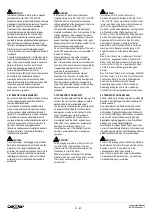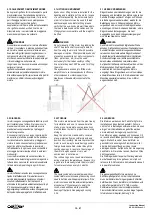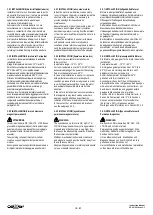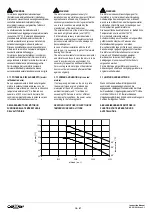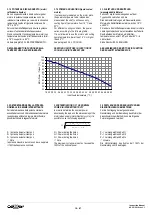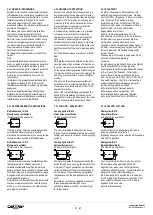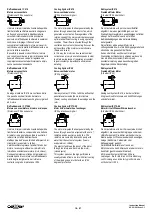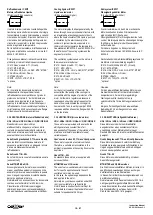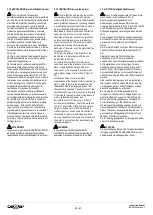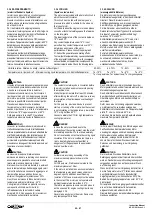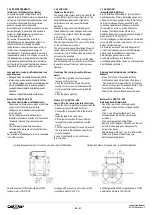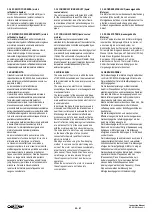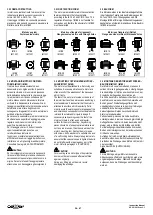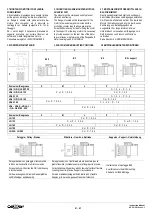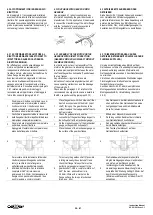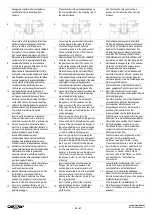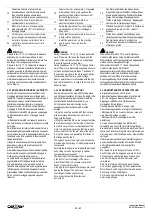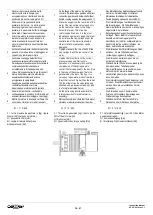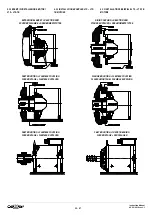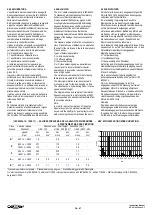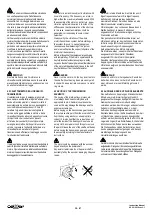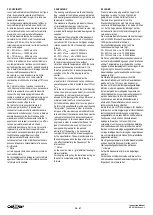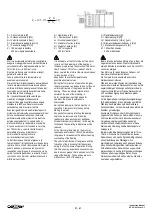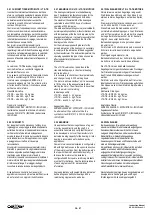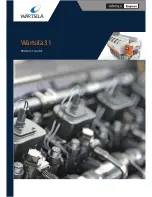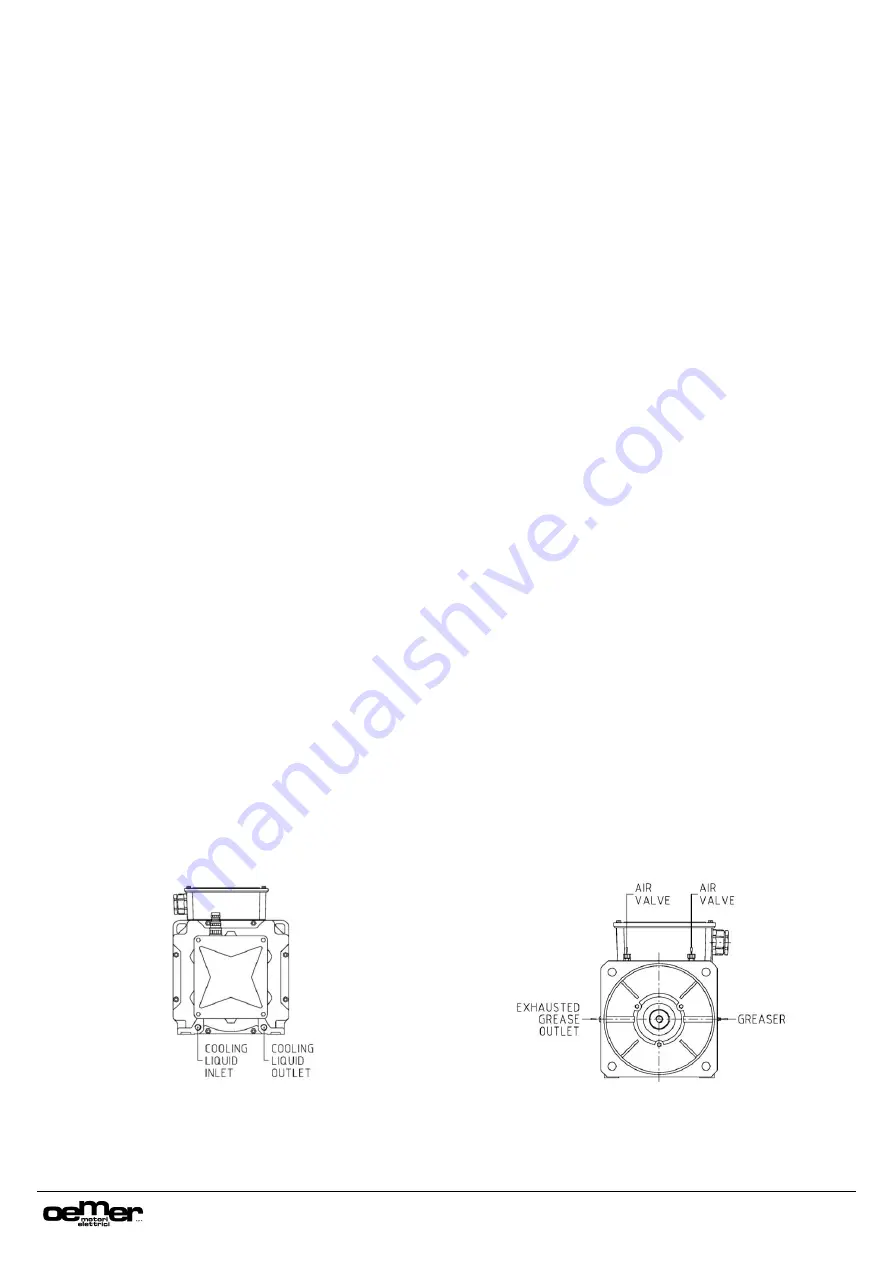
23 - 97
Instruction Manual
AC 02/2019-rev.1.1
3.3.4 RAFFREDDAMENTO
(motori con raffreddamento a liquido)
La qualità del liquido refrigerante è molto
importante per la vita del motore. La presenza di
calcare e/o impurità nel liquido determinano una
diminuzione delle prestazioni del motore e
possono causare danni irreparabili.
Raccomandiamo di utilizzare acqua comune (non
demineralizzata) con additivi anticorrosione e
sistemi di raffreddamento a circuito chiuso.
Vedere paragrafo 3.3.5 e 3.3.7.
Per evitare l’intasamento del circuito di
raffreddamento è indispensabile applicare un
filtro sul condotto di mandata del liquido
refrigerante con capacità filtrante pari a 100
m.
I motori sono consegnati senza liquido di
raffreddamento. Prima della messa in servizio e’
indispensabile riempire con il liquido il circuito di
raffreddamento ed eliminare eventuali impurità e
l’aria presente. Eventuali bolle d’aria all’inte
rno
del circuito e/o il mancato riempimento causano
la perdita di prestazioni e danni al motore.
Lavaggio del circuito di raffreddamento (con
acqua comune):
-
Collegare il tubo di mandata acqua al rubinetto di
immissione e lasciare aperto il rubinetto di ritorno.
-
Far circolare l’acqua per alcuni minuti all’interno del
circuito di raffreddamento in modo da eliminare
eventuali residui di metallo e sigillante presenti
all’interno.
-
Chiudere i rubinetti di mandata/uscita acqua.
Motori LQ / LQSR
100…280
Immissione del liquido di raffreddamento,
-
Posizionare il motore su di un piano orizzontale
con gli scarichi aria rivolti verso l’alto.
-
Collegare i tubi di mandata/ritorno liquido ai
relativi rubinetti.
-
Aprire i rubinetti contemporaneamente.
-
Immettere lentamente il liquido e far fuoriuscire
l’aria dalle valvole di sfiato poste sopra al
motore.
-
Controllare periodicamente e scaricare
l’eventuale aria presente nel circuito tramite le
valvole di sfiato.
Per eventuale raffreddamento con olio consultare
il ns. ufficio tecnico.
3.3.4 COOLING
(liquid cooled motors)
The quality of the coolant is very important for the
motor’s lifetime. Any furring or impurities in the
liquid determines a decrease of the motor
performances and may cause irrevocable
damages.
Always use clean water (not distilled water)
mixed with anticorrosion additives and closed
circuit cooling systems. Check the paragraph
3.3.5 and 3.3.7.
In order to avoid clogging of the cooling circuit, a
filter having a fineness of 100
m must be fitted
on the cooling delivery conduit.
The motors are shipped without being filled with
coolant. Before commissioning the motor, the
cooling circuit must be filled, cleaned and any air
inside must be expelled.
If air bubbles exist inside the circuit or the filling
has not been carried out correctly, this will reduce
the performances of the motor and may cause
damage.
Flushing of the cooling circuit (with clean
water)
-
Connect the input tube a the input tap and
leave open the output tap.
-
Flush the water for few minutes inside the
cooling circuit in order to eliminate possible
metal or seal small parts present inside the
circuit.
-
Close the input/output tap.
Motors LQ / LQSR 1
00…280
How to fill in the cooling liquid in the circuit,
-
Place the motor on a horizontal support with the
bleeder valves positionated on the top.
-
Connect the input/output tube to the relative
taps.
-
Open the taps at the same time.
-
Fill the liquid slowly and let the air flow out
through the air valve positionated over the
motor.
-
Check at regular intervals for any air present in
the circuit and in the affirmative case the air
must be expelled.
In case of cooling with oil, pls. contact our
technical office.
3.3.4 KÜHLUNG
(wassergekühlte Motoren)
Die Qualität des Kühlmittels ist sehr wichtig für
Lebensdauer des Motors.
Kalkablagerungen u/o
andere Verunreinungungen im Kühlmittel führen
zu einer Leistungseinbusse des Motors und
zukönnen irreparablen Schäden verursachen.
Wir empfehlen immer normales Wasser zu
benutzen (nicht destilliertes Wasser) mit
Rostschutzadditiven im geschlossenen Kreislauf.
Siehe Abschnitt 3.3.5 und 3.3.7.
Um Verstopfungen im Kühlkreislauf zu vermeiden,
muss ein Filter mit einer Feinheit von 100
m im
Zulauf installiert werden.
Die Motoren werden ohne Kühlmittel geliefert.
Vor der Inbetriebnahme muss der Kühlkreislauf
gefüllt, komplett entlüftet und eventuelle
Verunreinigungen entfernt werden.
Eventuelle Luftblasen im Kreislauf u/o
unvollständiges Befüllen führen zu Leistungverlust
oder Schäden am Motor.
Spülung des Kühlkreislaufes (mit klarem
Wasser)
-
Einen Schlauch am Wasserzulaufhahn
montieren und den Ablaufhahn offen lassen.
-
Den Kreislauf für einige Minuten mit Wasser
spülen, um eventuell vorhandene Metall- oder
Dichtmittelrückstände zu entfernen.
-
Die Eintritts- bezw. Ablasshahn schliessen.
Motore LQ / LQSR
100…280
Befüllung des Kühlkreislaufs,
-
Den Motor auf eine horizontale ebene
Unterlage stellen mit den Lüftungsventilen
oben.
-
Die Zu- und Ablaufschläuche mit den
entspechenden Kühlmittel Anschlüsse
verbinden.
-
Die Anschlüsse gleichzeitig öffnen.
-
Das Kühlmittel langsam einfüllen und die Luft
durch die oben gelegen Lüftungsventile
entweichen lassen.
-
Regelmässig prüfen auf Luft im Kühlkreislauf
prüfen und diese bei Bedarf über die
Entlftungventile ablassen.
Vista da lato opposto albero -
Non drive end view -
Ansicht Rückseite
Vista da lato albero -
Drive end view -
Ansicht Antriebsseite
Valvole scarico aria NON previste per LQ 280
tondo e motori LTS/LTS-TB
Air valves NOT present on motor size LQ 280
round frame and LTS-LTS-TB
Entlüftungsventile NICHT vorgesehen bei LQ 280
und Motoren der Serie LTS/LTS-TB

